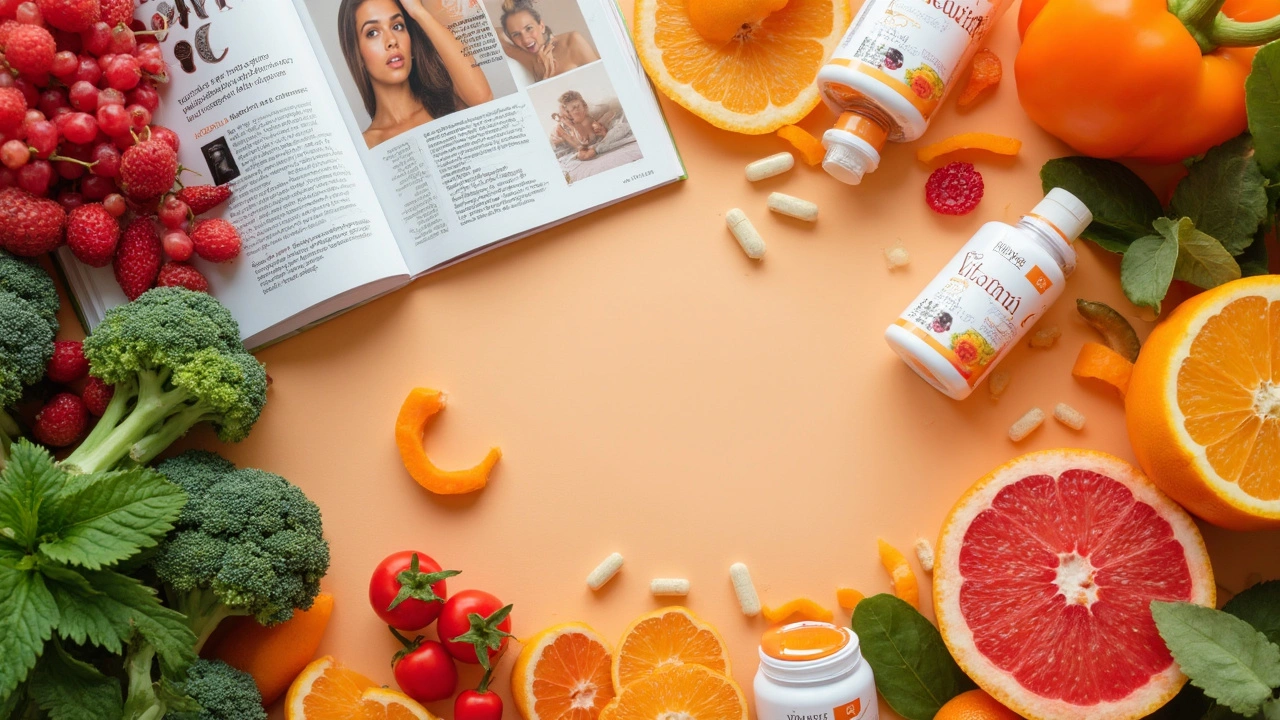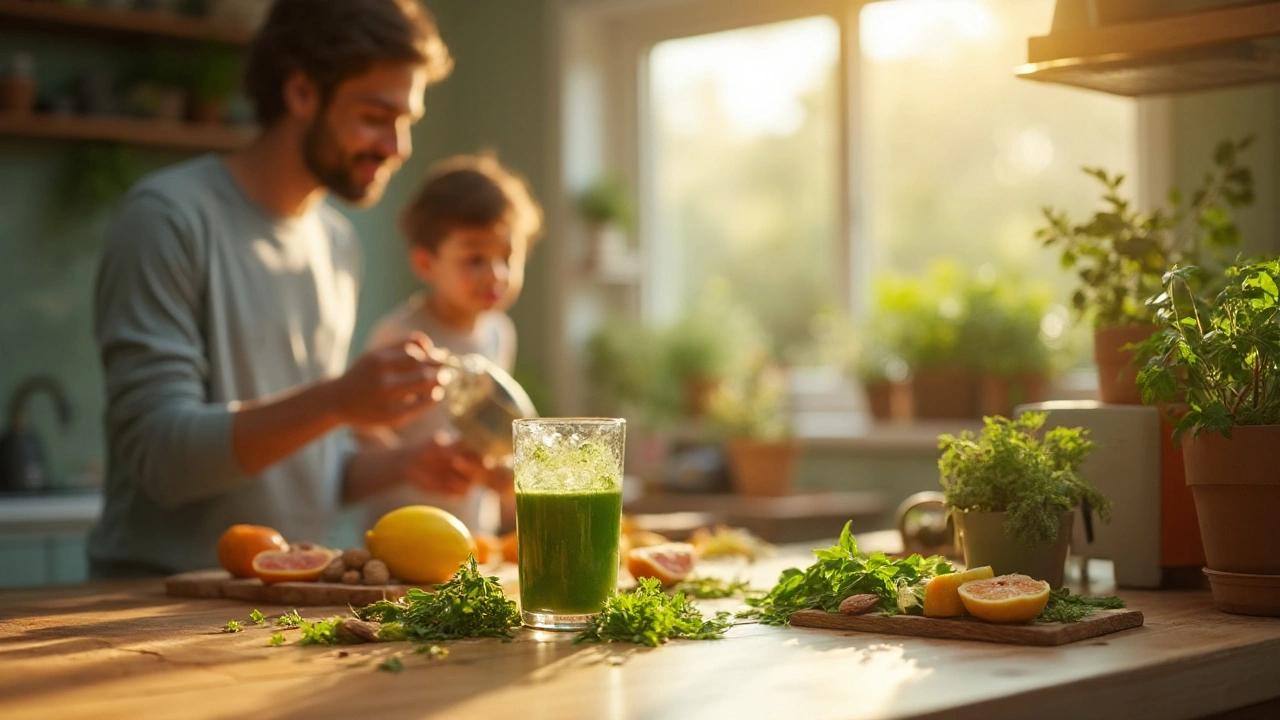Chilly mornings here in Dunedin sometimes make you feel like your skin is about as alive as last week’s lettuce in the fridge. But here’s a surprising reality: the real secret to glowy, plump, healthy skin isn’t in fancy creams or celebrity treatments. It’s vitamin C—the humble, citrus-powered nutrient your grandma probably pushed on you as a kid. But forget all the ad jingles and over-the-top marketing. Let’s look at why vitamin C is the ultimate beauty supplement and not just a good-for-you fruit friend. Science is pretty clear about this epic skin-boosting vitamin.
The Science Behind Vitamin C and Glowing Skin
Vitamin C isn’t just a “nice to have.” Your body can’t make it, so you’ve got to get it from your food or supplements. But what exactly does it do for skin? Think of vitamin C as your skin’s bodyguard, demolition crew, and artist all in one. One of its superstar roles is collagen production. Collagen is what keeps your skin bouncy and youthful, and as soon as you run low, hello wrinkles and sagging. Clinical studies have shown that adults with higher vitamin C intakes tend to have fewer wrinkles and less dryness. There was a big study out of the UK (the TwinsUK study, tracking thousands of women) that found those eating more vitamin C-rich foods had smoother skin and fewer visible lines. That’s not just a coincidence.
Now let’s talk about healing. That scrape from your weekend hike or random zit scar? Your skin rebuilds faster with vitamin C. It’s involved in every step of the repair process. It also fights the main bad guy in the skin ageing story: free radicals. These unstable molecules pop up thanks to sun, pollution, stress—even late nights and a cheeky glass of merlot. Vitamin C tackles them before they wreck your collagen or cause dark spots. That’s why diets low in vitamin C often show up as dull, uneven skin, and higher rates of visible damage. Not pretty, right?
On top of this, vitamin C inhibits melanin (the stuff that makes skin spots and uneven patches) so it actually helps fade existing dark spots over time. A research review published in the Nutrition Journal (May 2022) confirmed that consistent dietary vitamin C intake was linked to visible improvements in hyperpigmentation. The same doesn’t show up for lots of other trendy “miracle” ingredients. And here’s a fun fact: topical vitamin C works best when you’re already getting plenty through your diet. Basically, it stacks up the benefits, especially if you want that all-over glow instead of just treating one patch.
Why Supplements Beat Serums and Creams for Real Results
Fancy serums promise magic, and at $120 a pop, they should! But here’s the kicker: a lot of vitamin C creams degrade before you even open the lid or lose strength after exposure to air. And only a tiny amount actually makes it through your skin’s outer layer. The rest? Washed off the next time you cleanse. Dietary vitamin C, on the other hand, gets inside your body. It’s delivered by your blood straight to the places that need it most—your skin’s deepest layers, the collagen factories under the surface, and every cell trying to repair itself.
This is why you see more consistent results with supplements or vitamin C-dense foods. A standard 500–1000mg supplement gives your body a reliable, steady supply. Compare this with a topical serum (usually 15–20% at best) that maybe, just maybe, penetrates a few outer layers. Don’t get me wrong—topical vitamin C has its place, especially for targeting spots. But for full-face brightness and true repair, supplements are the heavy lifters.
But not all supplements are the same. Buffered or “gentle” vitamin C (like calcium ascorbate) is easier on your stomach and still does the job. Some people notice tummy rumbles or loose bowels with the cheap, super-high dose tablets. Honestly, your skin doesn’t need more than about 1000mg per day unless your doctor says so. And yes, your body does pee out the extra—that “expensive wee” joke is true. If you already eat tons of fresh fruit and veg, 250mg per day is typically enough to keep your glow going strong.
| Source | Vitamin C Content (mg per 100g) |
|---|---|
| Blackcurrants | 200 |
| Kiwi fruit | 92 |
| Strawberries | 60 |
| Oranges | 53 |
| Red capsicum | 120 |
That table isn’t just trivia—blackcurrants (huge here in New Zealand) are real superstars, easily topping oranges if you want the most vitamin C bang for your buck. A quick snack of two kiwi fruits gives you more than your daily recommended intake, and you’re getting fibre and extra skin-loving antioxidants too.

Real-World Tips to Boost Your Skin with Vitamin C
Getting that glow is easier than scrolling TikTok. Start by packing your meals with vitamin C-rich foods. Have berries on your oats, add red capsicum to your salad, squeeze a lemon wedge over steamed broccoli. One trick a local Dunedin dermatologist shared with me: eat your vitamin C-rich foods raw or only lightly cooked. Vitamin C is water-soluble and breaks down with heat—boiling those greens can lose up to 50% of their goodness! So, dip raw veggies in hummus, whip up fruit smoothies, or slice oranges over your yoghurt for a vitamin hit without losing potency.
If your diet’s not perfect (we all have those weeks), grab a good quality supplement. Slow-release tablets keep your levels steady through the day, which is useful if you want a sustained glow instead of a quick fix. Don’t fall for gimmicky “glow powders” with massive doses—your body can only absorb so much at once. Little and often is the smarter approach. Spread your intake across meals for best results.
Another game-changer: vitamin C with iron. It helps your body absorb non-heme iron from plants, so if you’re low on energy (and your skin’s dull and pale), pairing a C-rich snack with iron-rich foods makes a real difference. Think spinach salad with strawberries or chickpeas roasted with lemon.
Want to really supercharge things? Vitamin C teams up beautifully with vitamin E and zinc. Many beauty supplements bundle them because together, they protect your skin from sun, pollution, dehydration, and oxidative damage. Some people see results in just two weeks; studies suggest visible skin improvements in about 4–8 weeks of daily intake.
Just remember, more isn’t always better. Very high doses of vitamin C (above 2000mg per day) can give you tummy cramps or diarrhea. If you’re on medication or dealing with health conditions, run supplement plans by your doctor or pharmacist. Pregnant or breastfeeding? Vitamin C is generally safe but stick to recommended doses.
Myth-Busting: Vitamin C Myths and Must-Know Facts
You’ve probably seen endless beauty myths around vitamin C on socials. So, what’s true and what’s influencer hot air? First, vitamin C doesn’t bleach your skin. It reduces overproduction of melanin, so it fades dark spots and evens tone rather than lightening your actual complexion. Also, natural sources (like fruit and veg) work just as well as lab-made supplements—your body can’t tell the difference. Synthetic vitamin C, typically called ascorbic acid, is chemically identical to what comes from an orange.
Some folks panic about “acidic” supplements hurting their teeth or gut. In reality, most vitamin C tablets dissolve quickly and are swallowed before they touch teeth much. If you already have sensitive teeth or reflux, choose buffered forms or take supplements with food. And skip those “emergency” tablets with sugar and flavouring—too much sugar can dehydrate your skin and counteract some benefits.
There’s a trend online about using crushed vitamin C tablets as DIY face masks. Don’t. That’s a fast track to skin irritation, redness, or even burns. Leave skincare formulas to the pros. The best results come from vitamin C through your diet and maybe a targeted serum if you love your routine.
Ever wondered why some people swear by high-dose shots (IV vitamin C)? Unless you’re under a doctor’s care, there’s no scientific proof that megadoses improve skin for healthy folks. Moderation and consistency really are key. Plus, supplements won’t outpace bad habits—if you smoke, bask in the sun, or skip sleep, vitamin C can only do so much.

Building Your Daily Glow Routine: Simple Steps for Brighter Skin
Ready to put this into action? Here’s a no-fuss daily routine:
- Start your morning with a glass of water plus squeezed lemon or a kiwi. Super simple, and the vitamin C wakes up your skin before coffee hits.
- Pack your lunch with a mix of raw capsicum, tomatoes, or berries—these stay fresh and give you a mid-day vitamin boost.
- If you do supplements, pick a time you’ll remember each day. Consistency is more important than timing. If it’s with breakfast, great. If not, after lunch works just as well.
- Pair vitamin C-rich snacks with a handful of nuts or a spoonful of pumpkin seeds—vitamin C and E together work like a charm.
- Swap out one cooked veggie side for a raw one—think salad greens, carrot sticks, or snap peas. It’s easy and really ups your C intake.
To keep things fun, try new fruit or vege each week. New Zealand’s winter citrus—like tangelo or navel oranges—are loaded with flavor and vitamin C. If you’re more into savory than sweet, try sauerkraut or raw red cabbage. And of course, stay hydrated. Healthy skin needs water for all those nutrients to get where they need to go.
Down here in Otago, we see dry winds and sun exposure even in winter, which can really stress skin. A steady supply of vitamin C makes a radical difference, especially when teamed with SPF sunscreen and a basic moisturizer. If your routine’s weighed down by a dozen steps or products, let vitamin C simplify things. Think of it as the base layer for any skincare or beauty approach. Simple, powerful, proven—and easy to actually stick with.



18 Comments
Abhay Chitnis
Bro, vitamin C is just a fancy way to say 'eat more fruit'. I've been taking 5000mg daily and my skin looks like a neon sign. 🤡
Brandon Benzi
This is why America needs to stop trusting New Zealanders with skincare advice. We have our own science. And it involves zinc and protein.
Robert Spiece
Ah yes, the classic 'vitamin C fixes everything' narrative. The same way we once believed that eating fat made you fat. Science is a pendulum, and right now it's swinging between 'everything is a miracle' and 'everything is a scam'. You're just on the wrong side of the swing.
Vivian Quinones
I tried this and my skin looked better but then I got a cold so it was all pointless. Like, why even try? We're all gonna die anyway.
Eric Pelletier
The pharmacokinetics of oral vs. topical ascorbic acid are well-documented. Bioavailability of oral C is ~70-90% at doses <200mg, with renal excretion saturating above 200mg. Topical penetration is limited by stratum corneum barrier function-lipophilic esters like ascorbyl palmitate have better dermal uptake. Still, systemic delivery via diet ensures dermal fibroblast saturation. Supplemental 500-1000mg/day is clinically supported for collagen synthesis.
Marshall Pope
i think this is cool but i dont know if i believe it. i mean i eat oranges all the time and my skin still looks like a potato
Nonie Rebollido
I just eat kiwis. Two a day. No supplements. Skin’s good. Life’s good. 😌
Agha Nugraha
Makes sense. I’ve been eating blackcurrants since I was a kid in Kerala. My skin never gets dry. Maybe it’s not the supplement, just the habit.
Andy Smith
The data is clear: dietary vitamin C intake correlates with improved skin elasticity, reduced transepidermal water loss, and decreased hyperpigmentation. However, the effect size is modest, and individual variability is high. Supplementation beyond RDA (90mg/day for men) offers diminishing returns unless deficiency is present. Also, vitamin C is unstable in heat-steaming vegetables preserves more than boiling. And yes, the 'expensive wee' is real.
Rekha Tiwari
OMG YES!! I started eating raw red bell peppers with hummus and my dark spots faded in 3 weeks!! 🌈✨ I’m telling all my friends!!
Leah Beazy
I used to hate vegetables, but now I snack on strawberries like candy. My skin has never looked better. You don’t need fancy stuff. Just eat the rainbow!
John Villamayor
I’m from the Philippines and we eat a lot of guava and calamansi. My mom always said vitamin C keeps you young. Never needed a cream. Just fruit and sun protection
Jenna Hobbs
I tried this for 30 days and my skin looked like I’d been on a tropical vacation. I cried. I actually cried. My husband said I looked 10 years younger. I’m not even kidding. This changed my life.
Ophelia Q
I’ve had acne scars for years. After 6 weeks of daily 500mg + eating kiwi every morning, the redness faded so much. I’m so grateful. 🙏❤️
Elliott Jackson
I’ve read 147 studies on this. Vitamin C doesn’t work unless paired with hyaluronic acid and niacinamide in a pH 3.5 formulation. And even then, only if applied after microneedling. You’re all wrong.
McKayla Carda
I eat oranges every day. My skin is fine. Maybe just drink water?
Christopher Ramsbottom-Isherwood
You’re ignoring the placebo effect. People who take supplements believe they’re healthier. That’s why they report better skin. Correlation ≠ causation.
Stacy Reed
But what if you’re vegan and allergic to citrus? What then? Have you considered the trauma of food insecurity? Not everyone can afford kiwis. Maybe your 'glow' is just privilege dressed up as wellness.